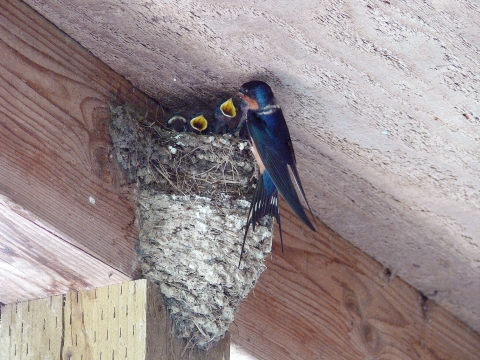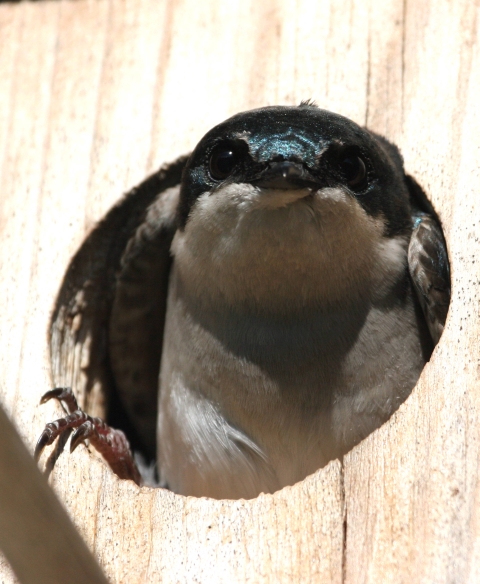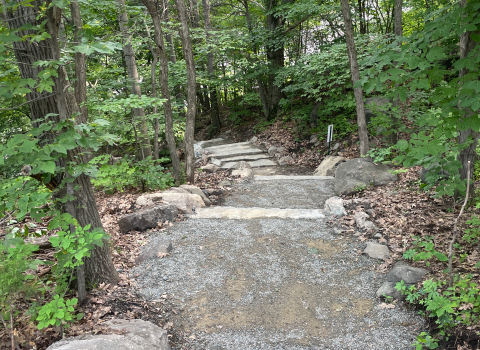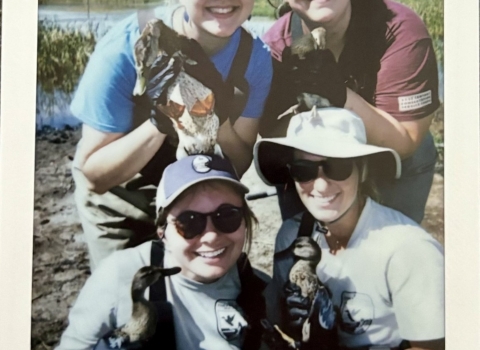There are eight species of swallows that regularly breed in North America: the bank swallow, barn swallow, cave swallow, cliff swallow, northern rough-winged swallow, purple martin, tree swallow, and violet-green swallow.
Natural history
After migrating north from their wintering grounds, mostly in Central America, cliff and barn swallows often nest on cliffs, canyons, bridges, and eaves of buildings. Swallows may construct an entirely new nest or they may use old nests, building off of traces of mud where an old nest used to be. The breeding season for swallows lasts from March through September. They often produce two clutches per year, with a clutch size of 3-5 eggs. Eggs incubate between 13-17 days and fledge after 18-24 days. However, chicks return to the nest after fledging for several weeks before they leave the nest for good. Swallow nests are made out of mud pellets, hair, grass, and feathers. Some differences between cliff and barn swallows are that cliff swallows nest colonially with several hundred birds in a colony while barn swallows nest solitarily. Swallow nests may contain mites and insects such as swallow bugs. Swallow bugs are closely related to bed bugs and are not a threat to humans.
Cliff swallows present a high degree of intraspecific brood parasitism. Individuals often lay eggs in other individuals’ nests within the same colony. It has been observed that some parasitic swallows have even tossed out their neighbors’ eggs and replaced them with their own offspring. Parasitized swallows had lower success in fledging their own chicks. This behavior has been adapted to increase the parasitic swallow’s offspring’s success by passing on the burden of taking care of chicks to another individual.
Ecological value of swallows
Swallows provide us with an ecological service as insect controllers. They particularly consume swarming insects such as bees, wasps, flies, damselflies, moths, grasshoppers, crickets, and more. It is common for people to post nesting structures in order to provide homes for these insect controllers.
Preventing human and swallow conflicts
Cliff and barn swallows may be considered a nuisance because they often nest within close proximity to humans and may produce large amounts of feces and other debris. To avoid any nuisance issues that nesting swallows may present, it is recommended to wash away feces frequently, place newspaper below nests to provide for easy clean up, and cover cars with tarp or plastic. If necessary, you may do the following to prevent birds from nesting:
Before birds arrive:
• Get rid of old nests and any traces of mud. Since old nests can be reused, get rid of any potential nests before the birds arrive from winter migration.
• Place physical barriers on potential nesting sites to prevent birds from nesting. You may use products such as coroplast, polytetrafluoroethylene (Teflon), Bird Slide™, plexiglass, plastic sheeting, or silicon-based paint coated to the surface. Physical barriers may be a permanent deterrent in preventing birds from nesting in nuisance locations.
After birds arrive:
• Wash away mud nests frequently, in between nest construction. They may eventually give up on that site if they are not successful in building a nest. You may only destroy nests that do not have eggs or chicks within.
• Play sounds of alarm and distress calls of cliff and barn swallows to disrupt nest construction.
Note about chemicals:
• Repellants are not effective.
• There are no toxicants registered under the U.S. Environmental Protection Agency (EPA) to control swallows.
Legal status
All swallows are state and federally protected under the Migratory Bird Treaty Act of 1918. It is illegal for any person to take, possess, transport, sell, or purchase them or their parts, such as feathers, nests, or eggs, without a permit. Active nests with eggs or chicks inside may not be touched or destroyed without a permit from the U.S. Fish and Wildlife Service. Inactive (empty) nests do not require a permit to destroy. Nest or bird removal applications must be justified with strong, compelling reasons such as a health or safety hazard towards humans and/or birds or damage to property. Check with your state government and the Service for migratory bird permits. The Service does not issue permits for bird nuisance issues.





